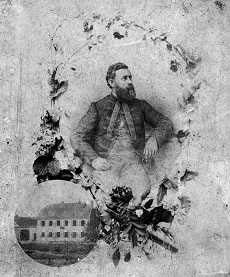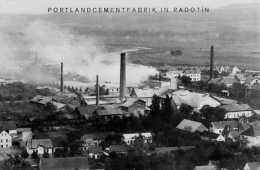History
Currently the oldest evidence of settlement here dates back to the Early Stone Age (around 130 to 50 thousand years ago) from Šachetský Stream, where evidence was also found of people having lived here in the Middle Stone Age. The fact that the location, with its river and undulating karst terrain, was ideal for settlement is witnessed by a whole range of significant archaeological artefacts. Perhaps the most notable of these was the discovery of a Roman gold coin (solidus) of Emperor of the Western Roman Empire Arcadius. Archaeological surveys were carried out when building “The place by the river” which uncovered several cultural layers and during which the second Roman coin was found within the area of Radotín.
The oldest written reference to Radotín is known only from a transcription from the 13th century. The first actual report which documents the existence of Radotín is therefore a deed of gift created by Vladislav II in 1158 in which there is a mention of a ford over the River Mže, the original name of what is now the River Berounka. Radotín is mentioned as being the property of the monastery in the founding deed of the monastery in Zbraslav of 10th August 1292; this state of affairs remaining until the Hussite Wars, when the monastery was ransacked and the ownership of Radotín passed to the aristocracy. It again found itself under the management of the monastery in 1536 and remained there, with an interruption of two years, until the monastery closed in 1785. The Thirty Year’s War was a time of poverty and suffering for Radotín. Wallenstein’s forces, the Saxons and the Swedes all passed through here, pillaging as they went.
Church of St. Peter and St. Paul
 The most significant reconstruction of the Church of St. Peter and St. Paul dates back to the subsequent Baroque period. What was originally an early Gothic structure, first referred to in 1298, underwent its first Baroque reconstruction between 1716 and 1718.
The most significant reconstruction of the Church of St. Peter and St. Paul dates back to the subsequent Baroque period. What was originally an early Gothic structure, first referred to in 1298, underwent its first Baroque reconstruction between 1716 and 1718.
The present appearance of the church is late Baroque, dating back to 1740 – 1750.
The cemetery which surrounds the church ceased to be used in 1880, although some tombstones do still remain. There was a wooden bell tower here until 1818, when a steeple and vestry were added.
Economic development
Prince Friedrich Öttingen-Wallerstein bought the entire Zbraslav demesne in 1825 following the closure of the monastery in Zbraslav and it was under his ownership that Radotín enjoyed considerable economic and cultural development. One development, aimed at preventing further disasters caused by flooding, was that the River Berounka was moved to a new bed in 1829.

Radotín was still an insignificant agricultural village in the first half of the 19th century.
Basket-makers prospered here thanks to the willow trees by the river. There were only 36 buildings here (including the school and the church), home to 301 people. The still waters were not disturbed until the revolutionary year of 1848 – Josef Macháček (see picture), a farmer, revolutionary, later industrialist, member of the provincial and imperial assembly and mayor of Radotín (and indeed father of Rézinka, the unfortunate love of prominent Czech writer Jan Neruda), stood at the head of the armed masses in Radotín.
Cement works and other new factories

There was significant industrial development in the second half of the 19th century, brought about by geological conditions and more. The main upturn was brought by the construction of a railway line joining Prague and Pilsen in 1862. Decorative marble and black limestone used to make pavement mosaics were mined in Radotín, lime was made, a cement works was built (permission for this being granted in 1871), a year later the foundation stone was ceremonially laid for a sugar refinery, a new school started to be built in the place of the old one and district roads gradually emerged.
The people that worked in the new factories moved to Radotín. The buildings that arose were mostly rural in type, the better homes lining the street known as “Panská” (Lordly). The community had four factories, 102 houses and 1,273 inhabitants at the end of the 19th century.
20th century
The events of the First World War did not pass Radotín by. Nonetheless, people came here from Prague for food, with writer Alois Jirásek even journeying to Josef Šarboch’s mill here for supplies.
Independence was announced on Monday 28th October 1918. The Council in Radotín decided that this momentous day be commemorated with the planting of three linden trees in front of the school building. Two are still there – simply raise your eyes to see their tops. A memorial was also erected in the park to commemorate the fifty-two soldiers that fell and died. The hamlet of Lahovská became part of Radotín in 1920 after the creation of the Czechoslovak Republic. Electricity was introduced to the community three years later, the newly-built Masaryk Burgher School opened in 1928 and a new gym hall in 1932. Radotín was also a very lively destination for day trips.
World War II mainly struck this place on the confluence of rivers at the very end, with strong German forces being launched against the Prague Uprising here. The liberating Russian army of General Vlasov stood against them in Radotín alongside the resistance.
Accommodation was required for the employees of the new cement works following the arrival of communism and concentration on heavy industry, with the “old housing estate” being built in 1959 and 1960. The chimney stacks of the old cement works in the middle of Radotín were demolished in 1963, to be replaced during the nineteen eighties and nineties with a new housing estate.
Town Radotín and Prague 16
Radotín was awarded town status on 14th September 1967, but then became part of the Capital City of Prague in 1974. It has had its own coat of arms since 1971, on which the castle walls standing over water symbolise the town that stands over the River Berounka and the cogged wheel the centre of industry.
Radotín became the headquarters of the administrative district in 2001 and has since then borne the official name of Prague 16. The Radotín of today is a place where people live well. There are countless sporting and cultural opportunities here to accompany the beautiful surroundings, which include protected landscape areas and natural landmarks such as the places known as Slavičí údolí, Staňkovka, Radotínské údolí, Černá rokle, Radotínské skály, Hvížďalka, Ortocerový lůmek, Cikánka and Lochkovský profil and the protected landscape area of Český kras (Bohemian Karst).